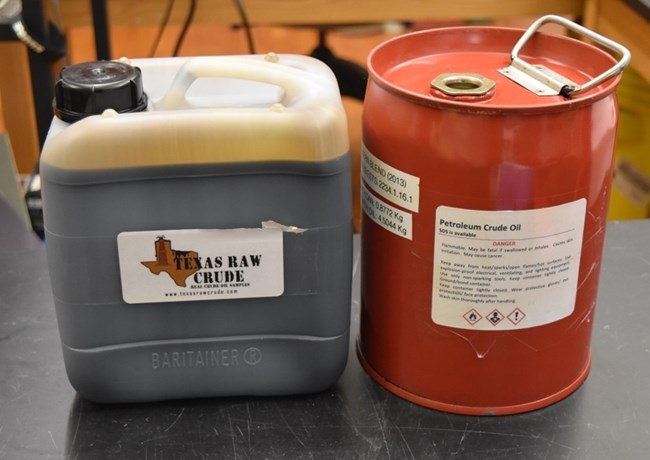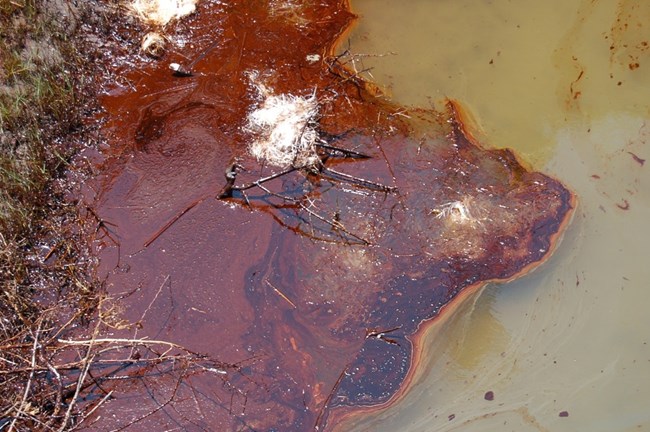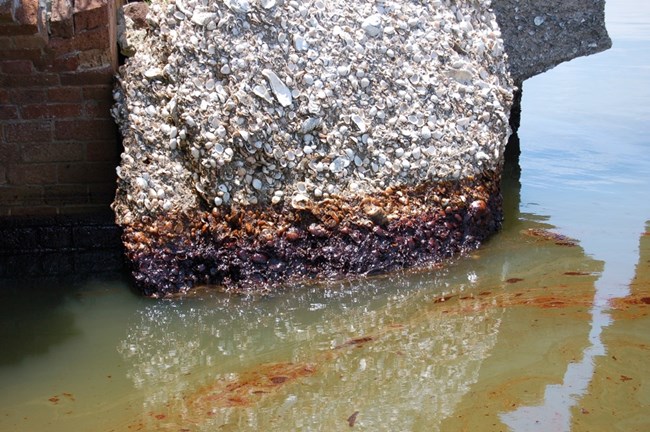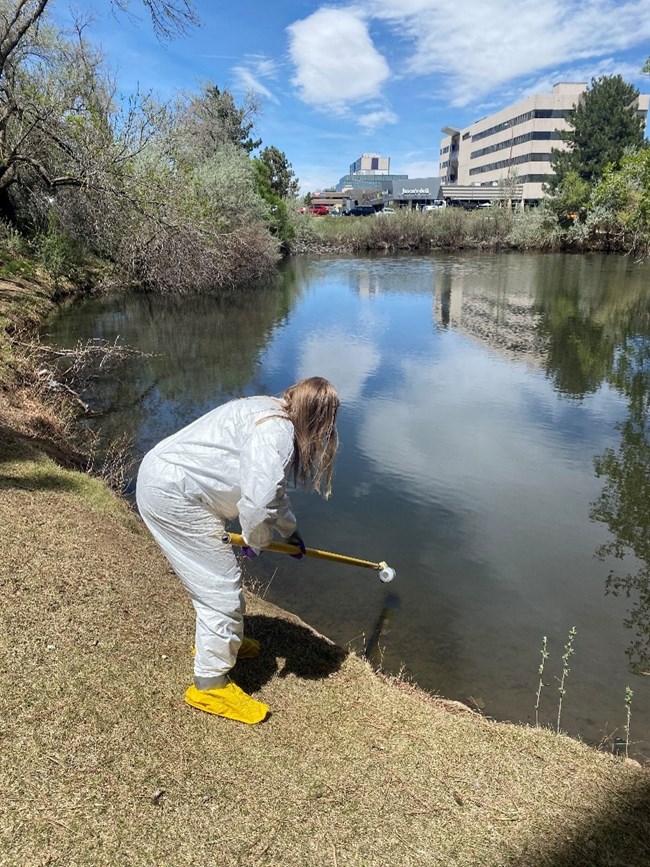Last updated: April 15, 2025
Article
Preservation Matters: Disasters- Oil Spills and Cultural Resources
This document is a guide for members of the response community responsible for the management and preservation of cultural resources. The information provided is based on research done at National Center for Preservation Technology and Training (NCPTT).
The brief discusses the primary considerations for looking at the contamination of oiled cultural resources.
Assessment
Identify the Oil Type
The oil types and their properties are most important when considering a response. Viscosity is the primary property used to classify crude oil and an indicator of how oil will interact with materials. While light oils are highly volatile and penetrate the porous surface of a historic substrate, heavy oils sit primarily on the surface, creating a barrier that may trap moisture in the material.
Petroleum-based oils are classified as:
-
Gasoline (specific gravity less than 0.80, API>45)
-
Light crude oils (specific gravity 0.80-0.85, API 35-45)
-
Medium crude oils (specific gravity 0.85-0.95, API 17.5-35)
-
Heavy crude oils (specific gravity 0.95-1.00, API 10-17.5)
-
Non-floating oils (specific gravity greater than 1.00, API<10)

Elisabeth Salmon, NPS
Gasoline products are highly volatile and most of the product will evaporate without significant residue. Light crude oils are mostly moderately volatile and can evaporate to no residue. Medium crude oils are moderately volatile and can be easily absorbed by porous materials. In the case of heavy crude or non-floating oils, the oil forms a residue on the surface in the form of a slick layer. In either of these cases, the oil spill may cause long-term damage to the material depending on the volume of the spill over the area. Each scenario demands different oil remediation tactics.
Weathering of Oil
After a spill, the oil is exposed to oxygen, and its density and viscosity increase as volatiles evaporate in a process often described as weathering. The process of weathering alters the properties of oils such as adhesion. Adhesion of West Texas Intermediate oil (Light to medium crude oil) can rise from 12 g/m2 to 33 g/m2 throughout the weathering process while the adhesion of diluted bitumen (Heavy crude oil) can increase from 98 g/m2 to 1580 g/m2. In the case of diluted bitumen, if the weathering is severe, the dilutant evaporates quickly within the first 48 hours of exposure to air. When weathered, the adhesion of diluted bitumen (measured in g/m2) can be three times that of heavy crude oil. Variations in adhesion and density mean that these oils present different challenges to a potential conservation strategy. Based on the results from the experiments at NCPTT, weathered substrates when soiled with light to medium viscosity oils were found to be more difficult to clean and remained stained as compared to unweathered samples. Whereas, in the case of weathered diluted bitumen, due to high adhesion the process of removal was difficult (as a lot of brushes were soiled) but the oil was also least absorbed in the substrate and had fewer stains as compared to the unweathered diluted bitumen.

Jason Church, NPS
Spill Type
The spill types can be defined broadly based on their procurement and transportation methods – water and land. With this substantial need for crude oil, transportation by truck, rail, pipeline, and ship increased in the last century, making spills inevitable. The spills lead to indiscriminate contamination of surrounding environments, including cultural and historical sites. The release of crude oil into the environment can occur during transportation over water or land, because of operational discharge, faulty equipment, human error, disaster, or a damaged pipeline.
Source
Depending on the source of the spill, pressure, and volume, damage to cultural resources can increase. Furthermore, the condition can worsen in an active source of the spill. A burst pipeline may continue to disperse oil, or tidal wave action may cause reoiling of the resources on the coast, increasing the likelihood of cleaned resources being oiled again. It is important to understand the source of the spill before any preservation action is taken.
Cultural Resources
Cultural heritage is defined as the tangible and intangible attributes of people, culture, and their cultural landscape inherited from past generations. These include:
-
material artifacts
-
historic buildings and structures
-
archeological sites and collections
-
fine art, ethnographic collections, and objects
-
planned and maintained landscapes, such as a cemetery or historic park.
Significance
Under the guidance of the U.S. National Register of Historic Places, the quality of significance of cultural resources in American history, architecture, archeology, and culture is present in districts, sites, buildings, structures, and objects that possess integrity of location, design, setting, materials, workmanship, feeling, and association, and:
-
Criterion A: that are associated with events that have made a significant contribution to the broad patterns of our history.
-
Criterion B: that are associated with the lives of persons significant in our past.
-
Criterion C: that embody the distinctive characteristics of a type, period, or method of construction, that represent the work of a master, that possess high artistic values, or that represent a significant and distinguishable entity whose components may lack individual distinction.
-
Criterion D: that have yielded, or may be likely to yield, information important in prehistory or history.
Listing
The National Park Service (NPS), State Historic Preservation Office (SHPO), Tribal Historic Preservation Office (THPO), and the local historic district should be contacted to check if the cultural resource at risk is listed on their register(s).

Jason Church, NPS
Substrate Materials and Conditions
Before cleaning, the resource should be evaluated for material type, texture, and surface treatment before considering any cleaning action. Soft and sensitive materials like plasters, painted surfaces, adobe, shell, timber, ornamentation, or sculpture in stone should be treated sensitively and checked to ensure cleaning action doesn’t eradicate the historic layer. Hard materials such as stones, brick, and concrete should be checked for any visible cracks or spalling that would make them vulnerable to cleaning damage.
Considerations for Response
Cleaning may be considered where the oil spill is affecting the significance, preservation status, integrity, and value of the cultural resource. It may also depend on the use of the cultural resource i.e. the human and animal traffic exposed to the oiled materials.
Importantly, the cleaning should only be considered where the recovery actions are not causing more harm than leaving the oil in place.
Pre-approvals are required from the Regional Response Teams (RRTs) for using chemicals for cleaning.
A detailed response action plan is recommended.

Vrinda Jariwala, NPS
Personal Protection Equipment (PPE) based on Level A, B, C, D
-
Chemical resistant suit/ non-gas tight suit/ Tyvek suits
-
Rubber boots
-
Gloves – Latex-free or Neoprene rubber
-
Full face mask/Respirator (fit tested)/ N95 mask
-
Safety glasses (where it isn’t a full-face mask)
Protect the Resource and Surrounding Area
Before cleaning, cover areas of the resource that were not impacted by the oil spill prevent contamination.Decontamination
-
Decontaminate protective gear
-
Remove PPE so the outer layer is inside like suit, Tyvek, gloves, etc.
-
Avoid contaminating regular clothing
-
Remove the respirator at the end.
Waste Management
The oil, oil spill waste, wastewater from cleaning, clean-up waste, and contaminated tools such as brushes should be treated or disposed of per State and Federal guidelines. Wastewater from cleaning should not be allowed to enter the surface or groundwater before testing it to see if it is fit for disposal.
References
Environment Canada. “Environment Canada Crude Oil and Petroleum Product Database.” Online: https://open.canada.ca/data/en/dataset/53c38f91-35c8-49a6-a437-b311703db8c, 2017.
Diane, M. et al. “Spills of Diluted Bitumen from Pipelines: A Comparative Study of Environmental Fate, Effects, and Response Committee on the Effects of Diluted Bitumen on the Environment.” (Washington, D.C.: The National Academies Press, 2016)
Fieldhouse, B. et al., “Results from Effectiveness Testing of Chemical Countermeasures and Sorbent Performance on Oil Sands Product.” (Proceedings of the Thirty-ninth AMOP Technical Seminar. (Ottawa: Environment and Climate Change, 2016).
Jariwala, V. “Examination of Surface Washing Agents for Conservation of Oiled Historic Materials Phase III report.” (National Center for Preservation Technology and Training, Inland Oil Spill Preparedness program grant, 2021).
National Conservation Training Center, “Inland Oil Spill Response for the Department of the Interior.” (U.S. Fish & Wildlife Service, revised 2019).
National Park Service, “How to Apply the National Register Criteria for Evaluation.” (National Register Bulletin, 1990.)
Salmon, E., “Examination of Surface Washing Agents for Conservation of Oiled Historic Materials Phase I report.” (National Center for Preservation Technology and Training, Inland Oil Spill preparedness program grant, 2019.)
Author and Editor
Author: Vrinda Jariwala, Research Associate, NCPTTSeries Editor: Kirk A. Cordell, NCPTT Executive Director
Cover Photo: Jason Church, NPS
About NCPTT
The National Center for Preservation Technology and Training (NCPTT) is a research, technology and training center within the National Park Service. NCPTT publishes its Preservation Matters Series to provide easily accessible guidelines for preserving cultural materials.

